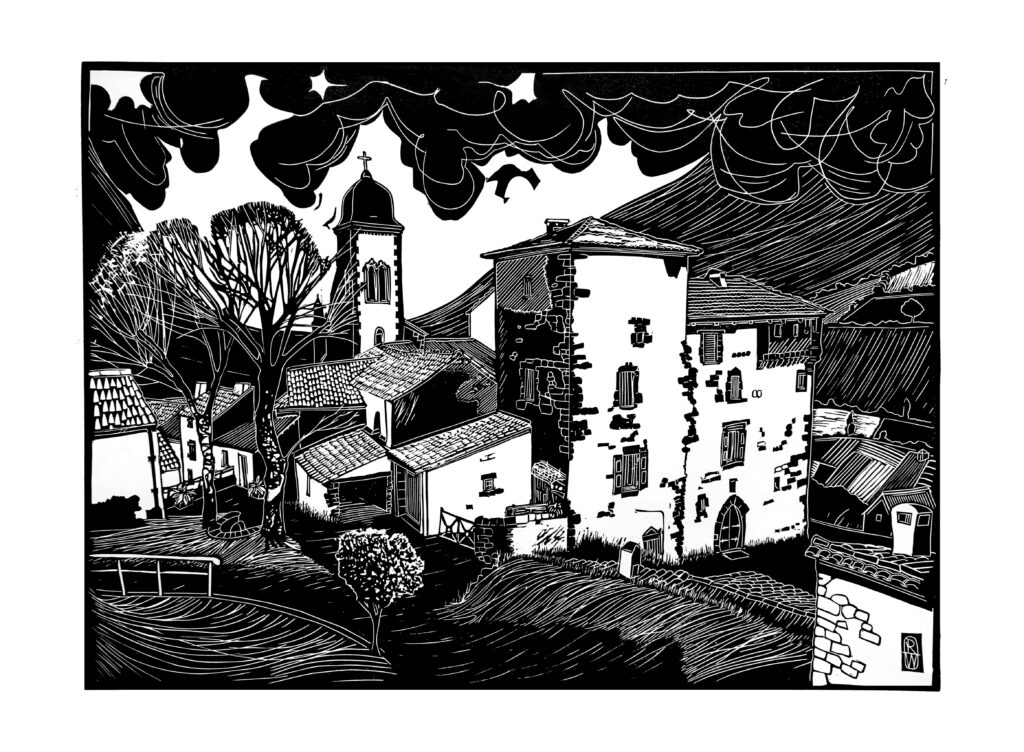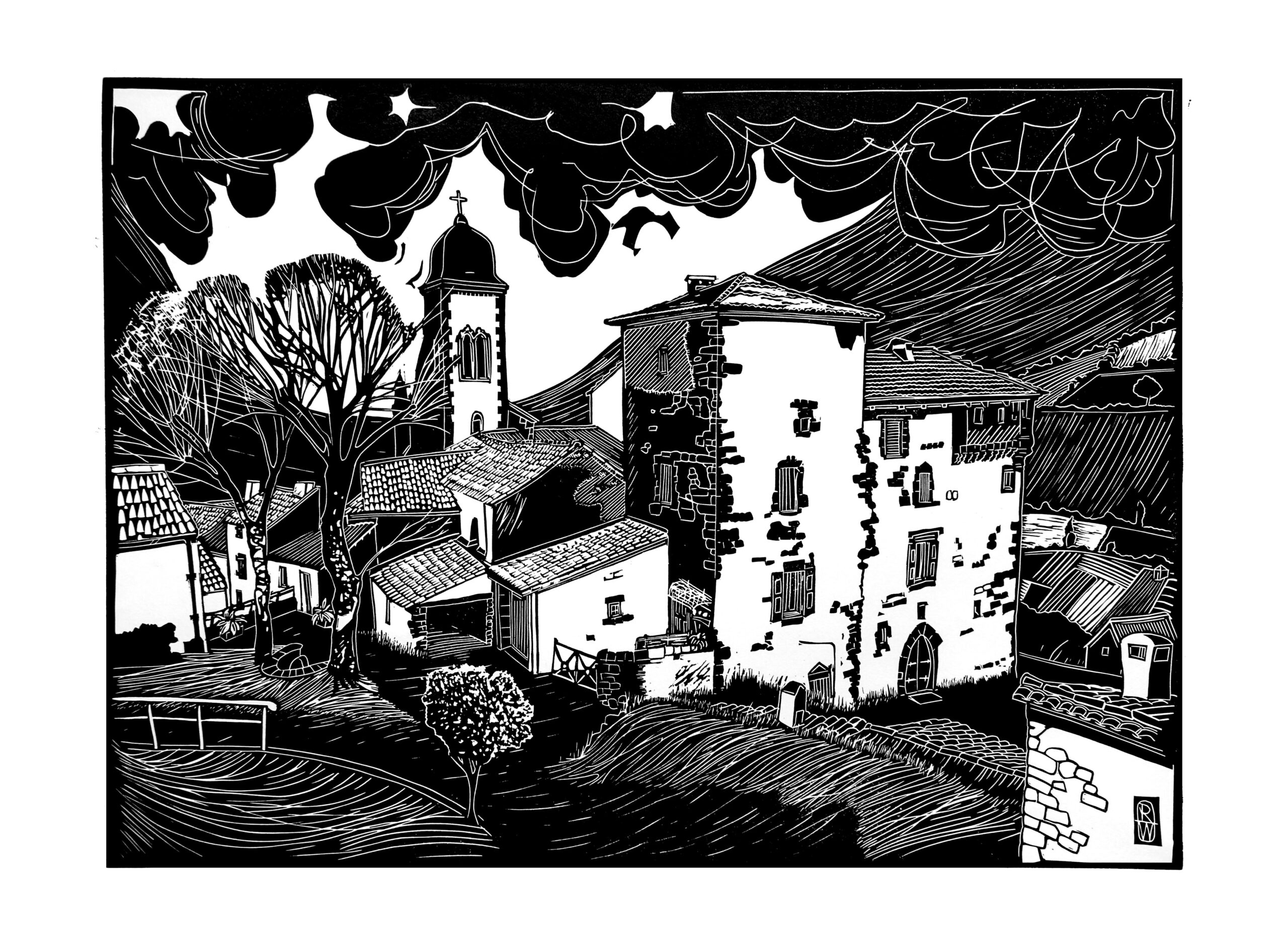C’est une zone d’énormes gorges calcaires, de hauts plateaux incisés par des rivières coulant dans des vallées fertiles. Je me sens heureuse ici. J’aime le chêne et l’origan à la lisière du pays le plus rude – bien que cela ne compte guère comme tels …
Journal, mardi 25 février, Robin Wilson (2020)
This is a single block linocut at about A3 size – 420mm x 297mm – which I cut at the very outset of the 2020 Covid-19 lockdown in Britain. The basis of this was a fairly simple sketch and a background of diary notes and photographs that I tool on site while I was wandering round and round the hilltop getting the feel of the place.

£145.00 unframed
Linocut (single block) Edition Size: only as two A/Ps
Size 420mm x 297mm (A3) Zekall 145 gsm
Part of the reason for doing these large linoblocks is the thrill of printing the things off. They really fill the paper, and they’re working at nearly the maximum size that the Vandercook proofing press we have can handle.
Doing something so large also gives me the opportunity to demonstrate one or two techniques that I wanted to record and publish online for my students at the Bodleian Bibliographic Press. In a big image like this, lots of issues arise during the carving. Being able to recognise and anticipate the issues as (or before) they arise is a good skill to develop. It’s something I’ve learned for myself by experience mainly as I’ve gone along; and it’s something I try to teach the students at the Bodleian Bibliographic Press, where under more normal circumstances I would now be teaching printmaking workshops.
I know lots of them will be missing their printmaking classes all this term so I decided to put up one or two posts from various projects I’m working on at home during lockdown. These big images take time, so the posts tend to appear over the course of a week or so, which is about the length of time that it takes me to produce them from starting the sketch to finishing printing off the proofs.
The first of the excerpts on my Studio Instagram site here: Linocut #1
If you follow The Wytham Studio Instagram post, and look back in time, you’ll see the kinds of images I’ve been making over the past couple of years and also get a feel for the studio and the workshop in Oxford where I make them. You’ll also see some of the other projects I run, most notably the Oxford University Kilns Project, which is a long term piece of anthropological research I set up using woodfired ceramics kilns to investigate contemporary craft practices – transmission of skills and information and so on. I’ll talk about it in another post some time. If you look at my Instagram posts you’ll see that they alternate between ceramics and print. When the kilns are firing, they take over everything and all of my time. When they’re not, then I try to get back to printmaking, teaching and writing. Ignore the bits that don’t interest you, explore the bits that do.
The Studio and The Workshop are two different places, you’ll note. I hadn’t realised until someone asked me recently about how we fit all the presses into a small studio in the woods. And of course we don’t.
The Wytham Studio is our printmaking base at the University of Oxford’s Wytham Woods, where Rosie my partner and I set it up as founding Resident Artists in 2012. It’s where we keep our 1850 Albion Press that came out of the Ruskin School of Fine Art and its in the middle of the 1000 acre research woodland that we most often teach our weekend printmaking courses. The website is here: http://www.thewythamstudio.co.uk
By contrast, The Workshop is a kind of printing collective, located in a former car garage at 50 Hurst Street Studios off the Cowley Road in Oxford. We share it with the printer Richard Lawrence and a few others. Its oily, industrial and very functional. Quite different to the studio. Its as close as Oxford gets to urban grunge. The Workshop is not a part of the University, which is one of the reasons why we have all our big Vandercook proofing presses, guillotines, circular saws and letterpress type there. There are also monotype casters, supercasters, Heidelberg cylinders and platen presses, a Ludlow (!) and a whole lot more.
Finally, you’ll maybe see a few images from the workshops and classes that we run as tutors at the Bodleian Bibliographic Press, which is located in the Old Schools Quad of the University, the very oldest core of the sprawling miracle that is Oxford University. So that’s our three main printing locations in and Oxford, within the University and outside it. And because we can’t easily use any of them at the moment, we’re printing at home. Which brings me back to the Instagram posts of the Image of St. Geniez de Bertrand, which I used as an example of how I make my large single block linocuts. I’ll go through that process step by step in my next post, putting together the Instagram posts into a single document.
